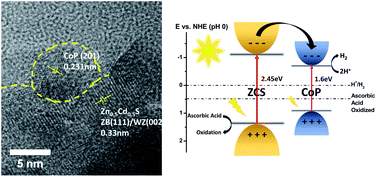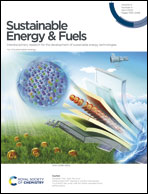Interfacial engineering of a zinc blende/wurtzite homojunction photocatalyst through hybridization with a cobalt phosphide co-catalyst for enhanced visible-light-driven photocatalytic H2 evolution†
Abstract
The incorporation of cobalt phosphide (CoP) as a noble-metal-free co-catalyst onto Zn0.5Cd0.5S with a unique zinc blende/wurtzite (ZB/WZ)-homojunction structure (ZCS) has resulted in significantly enhanced photocatalytic activity. The optimized sample, 3CoP–ZCS, yielded an exciting 20-times enhancement in H2 evolution (∼4.9 mmol h−1 g−1) over pristine ZCS under visible light irradiation. The enhancement was ascribed to the synergistic interaction between the ZB/WZ homojunctions and the close heterojunction formed between ZCS and CoP. Besides being able to effectively suppress the electron–hole recombination, the introduction of CoP was also proven to boost the light absorption ability of the composite in the visible light region. Owing to these beneficial aspects, it was evident that CoP serves as an efficient co-catalyst for photocatalytic H2 evolution.



 Please wait while we load your content...
Please wait while we load your content...